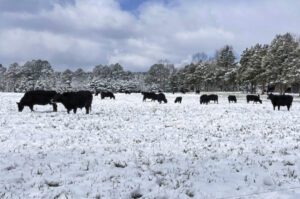While drought and other economic challenges tightened the U.S. cattle herd in recent years, the constriction eventually created a significant upswing in profitability for many beef cattle producers.
As 2023 ended, many cow-calf and feeder producers were experiencing record profits, with experts forecasting this upward cycle to continue for several years.
This upturn and the resulting increase in working capital create opportunities for producers in 2024.
But even as they examine the right opportunities for their operations, producers should continue to manage costs, consider long-term implications, and make strategic decisions that position them to face a future that will continue to change.
That’s according to Josh Davis, vice president of agribusiness at Farm Credit Mid-America.
Increased profitability may enable a producer to set his or her operation up to be more efficient without borrowing as much from lines of credit.
For some, this could mean scaling the operation to add cows or handle higher volumes of cattle.
For others, it could mean investing in equipment, rolling stock, or livestock handling facilities to make the operation run more efficiently.
While capital investments could reap profitable rewards in the future, they should always be planned strategically.
Expand with long-term viability in mind. Producers should consider the financial sustainability of any investment or expansion they are planning over time.
Will the implications of an investment made today be viable several years down the road when the market isn’t as profitable?
Operations with multiple segments or enterprises will be well served to examine the performance of each and invest in growing the most profitable segment of the business.
Consider an operation’s limitations. Every operation has constraints, and producers should examine how capital investments may impact their current limitations both in the short and long term.
There will be a point when growth requires taking on additional resources or costs, like added labor. If those additional expenses are not sustainable over time, that growth strategy may not be right for the operation.
Relationships are essential in the world of agriculture, and the beef industry is no exception.
Many seasoned and beginning cattle producers credit their beginnings to relationships built with family members, friends, and trusted mentors found within their local communities.
These relationships add value to the business and are important throughout the life of an operation.
Build and utilize a panel of advisers. “We routinely encourage our customers to create and maintain a panel of trusted advisers to serve as a sounding board for major business decisions,” Davis said.
This panel is especially important during times of increased profitability and can help the producer examine opportunities on the table, discuss risks involved, and make sure the appropriate risk mitigation tools are in place.
It can also prove invaluable when the time comes to create a succession plan for the business.
The strongest advisory panels will have a variety of perspectives that both challenge and encourage owners to think through different implications of business decisions. Consider including a mentor, accountant, attorney, and lender as advisers.
Invite a local ag Extension agent to serve in an advisory capacity for the operation. These agents offer insight into the local market and can provide valuable perspectives about opportunities and challenges during all cycles of the market.
This insight is especially valuable for producers who are considering growth or an expansion into a niche segment of the industry.
Make larger purchases more viable. While there are some investments that an individual producer may not be able to justify doing alone, those purchases may be more viable and affordable in the long run if made in partnership with neighboring producers or family members.
This works well for investments that may not be used every day but will improve the efficiency of the operation over time such as a portable corral or bale wrapper.
If expansion isn’t something a producer wants to invest in this cycle, they can still make their operation more stable and efficient. This begins with improving its overall financial position. Maintaining that improvement over time will contribute to long-term stability.
Build and maintain working capital. In prior years, it may have been difficult for producers to build a war chest of working capital for the operation.
While increased profitability makes this less challenging, producers should examine their books and set standards for the operation’s financials. These standards should include the amount of working capital needed as a cushion to adversity.
Stick to the budget. Even in an upward market, producers should be diligent to stick to the operation’s budget and manage costs.
Discipline is important regardless of the economic environment and will enable the producer to optimize opportunities and maximize success.
Reduce debt and use credit wisely. Once a minimum threshold of working capital has been built, it may make financial sense to use some working capital to pay down high-interest debt and save the operation thousands of dollars in interest payments over time.
This approach could also free up lines of credit and strengthen the operation’s ability to borrow in times when credit is really needed.
Producers who do plan to leverage credit for capital expenditures may explore lower, fixed interest rate loans over using existing lines of credit.
They can also ask if their lender offers the opportunity to convert loans to lower interest rates when they do come down instead of refinancing.
Maintain risk management tools. Risk management and mitigation tools should continue to be part of the operation’s financial and growth strategy, even in times of higher profitability.
The past several years have shown the market can change quickly. Risk mitigation tools provide an additional layer of security against volatility or when the market turns lower.
It holds true no matter the market that what works for one producer may not be the right approach for another.
Taking strategic steps during market upcycles to improve the financial position of their unique operation while adapting a long-term mindset will better prepare producers to navigate the marketplace both today and tomorrow.
+++30+++
